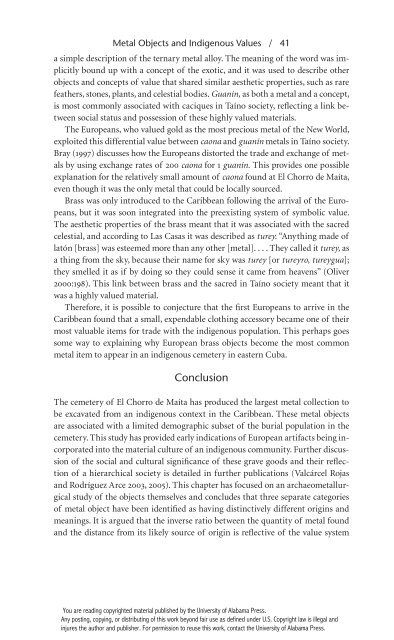Crossing the Borders: New Methods and Techniques in the Study of Archaeological Materials from the Caribbean
by Corrine L. Hoffman, et. al.
by Corrine L. Hoffman, et. al.
Create successful ePaper yourself
Turn your PDF publications into a flip-book with our unique Google optimized e-Paper software.
Metal Objects <strong>and</strong> Indigenous Values / 41<br />
a simple description <strong>of</strong> <strong>the</strong> ternary metal alloy. The mean<strong>in</strong>g <strong>of</strong> <strong>the</strong> word was implicitly<br />
bound up with a concept <strong>of</strong> <strong>the</strong> exotic, <strong>and</strong> it was used to describe o<strong>the</strong>r<br />
objects <strong>and</strong> concepts <strong>of</strong> value that shared similar aes<strong>the</strong>tic properties, such as rare<br />
fea<strong>the</strong>rs, stones, plants, <strong>and</strong> celestial bodies. Guanín, as both a metal <strong>and</strong> a concept,<br />
is most commonly associated with caciques <strong>in</strong> Taíno society, reflect<strong>in</strong>g a l<strong>in</strong>k between<br />
social status <strong>and</strong> possession <strong>of</strong> <strong>the</strong>se highly valued materials.<br />
The Europeans, who valued gold as <strong>the</strong> most precious metal <strong>of</strong> <strong>the</strong> <strong>New</strong> World,<br />
exploited this differential value between caona <strong>and</strong> guanín metals <strong>in</strong> Taíno society.<br />
Bray (1997) discusses how <strong>the</strong> Europeans distorted <strong>the</strong> trade <strong>and</strong> exchange <strong>of</strong> metals<br />
by us<strong>in</strong>g exchange rates <strong>of</strong> 200 caona for 1 guanín. This provides one possible<br />
explanation for <strong>the</strong> relatively small amount <strong>of</strong> caona found at El Chorro de Maíta,<br />
even though it was <strong>the</strong> only metal that could be locally sourced.<br />
Brass was only <strong>in</strong>troduced to <strong>the</strong> <strong>Caribbean</strong> follow<strong>in</strong>g <strong>the</strong> arrival <strong>of</strong> <strong>the</strong> Europeans,<br />
but it was soon <strong>in</strong>tegrated <strong>in</strong>to <strong>the</strong> preexist<strong>in</strong>g system <strong>of</strong> symbolic value.<br />
The aes<strong>the</strong>tic properties <strong>of</strong> <strong>the</strong> brass meant that it was associated with <strong>the</strong> sacred<br />
celestial, <strong>and</strong> accord<strong>in</strong>g to Las Casas it was described as turey. “Anyth<strong>in</strong>g made <strong>of</strong><br />
latón [brass] was esteemed more than any o<strong>the</strong>r [metal]. . . . They called it turey, as<br />
a th<strong>in</strong>g <strong>from</strong> <strong>the</strong> sky, because <strong>the</strong>ir name for sky was turey [or tureyro, tureygua];<br />
<strong>the</strong>y smelled it as if by do<strong>in</strong>g so <strong>the</strong>y could sense it came <strong>from</strong> heavens” (Oliver<br />
2000:198). This l<strong>in</strong>k between brass <strong>and</strong> <strong>the</strong> sacred <strong>in</strong> Taíno society meant that it<br />
was a highly valued material.<br />
Therefore, it is possible to conjecture that <strong>the</strong> first Europeans to arrive <strong>in</strong> <strong>the</strong><br />
<strong>Caribbean</strong> found that a small, expendable cloth<strong>in</strong>g accessory became one <strong>of</strong> <strong>the</strong>ir<br />
most valuable items for trade with <strong>the</strong> <strong>in</strong>digenous population. This perhaps goes<br />
some way to expla<strong>in</strong><strong>in</strong>g why European brass objects become <strong>the</strong> most common<br />
metal item to appear <strong>in</strong> an <strong>in</strong>digenous cemetery <strong>in</strong> eastern Cuba.<br />
Conclusion<br />
The cemetery <strong>of</strong> El Chorro de Maíta has produced <strong>the</strong> largest metal collection to<br />
be excavated <strong>from</strong> an <strong>in</strong>digenous context <strong>in</strong> <strong>the</strong> <strong>Caribbean</strong>. These metal objects<br />
are associated with a limited demographic subset <strong>of</strong> <strong>the</strong> burial population <strong>in</strong> <strong>the</strong><br />
cemetery. This study has provided early <strong>in</strong>dications <strong>of</strong> European artifacts be<strong>in</strong>g <strong>in</strong>corporated<br />
<strong>in</strong>to <strong>the</strong> material culture <strong>of</strong> an <strong>in</strong>digenous community. Fur<strong>the</strong>r discussion<br />
<strong>of</strong> <strong>the</strong> social <strong>and</strong> cultural significance <strong>of</strong> <strong>the</strong>se grave goods <strong>and</strong> <strong>the</strong>ir reflection<br />
<strong>of</strong> a hierarchical society is detailed <strong>in</strong> fur<strong>the</strong>r publications (Valcárcel Rojas<br />
<strong>and</strong> Rodríguez Arce 2003, 2005). This chapter has focused on an archaeometallurgical<br />
study <strong>of</strong> <strong>the</strong> objects <strong>the</strong>mselves <strong>and</strong> concludes that three separate categories<br />
<strong>of</strong> metal object have been identified as hav<strong>in</strong>g dist<strong>in</strong>ctively different orig<strong>in</strong>s <strong>and</strong><br />
mean<strong>in</strong>gs. It is argued that <strong>the</strong> <strong>in</strong>verse ratio between <strong>the</strong> quantity <strong>of</strong> metal found<br />
<strong>and</strong> <strong>the</strong> distance <strong>from</strong> its likely source <strong>of</strong> orig<strong>in</strong> is reflective <strong>of</strong> <strong>the</strong> value system<br />
You are read<strong>in</strong>g copyrighted material published by <strong>the</strong> University <strong>of</strong> Alabama Press.<br />
Any post<strong>in</strong>g, copy<strong>in</strong>g, or distribut<strong>in</strong>g <strong>of</strong> this work beyond fair use as def<strong>in</strong>ed under U.S. Copyright law is illegal <strong>and</strong><br />
<strong>in</strong>jures <strong>the</strong> author <strong>and</strong> publisher. For permission to reuse this work, contact <strong>the</strong> University <strong>of</strong> Alabama Press.


















